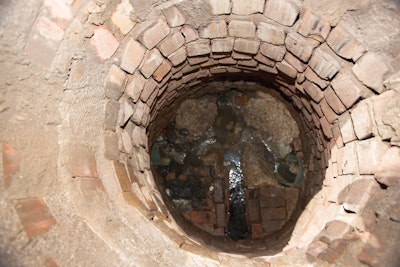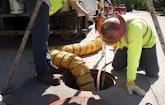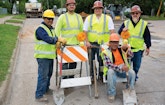
Roberto Lopez jackhammers surface material around a manhole at the start of a rehabilitation project in Davenport, Iowa.
Interested in Municipal/Industrial?
Get Municipal/Industrial articles, news and videos right in your inbox! Sign up now.
Municipal/Industrial + Get AlertsIt may seem far-fetched that two former physical education teachers would make abrupt career changes and build a multimillion-dollar-a-year manhole rehabilitation business, but that’s exactly what Kim and Lawrence Vallow did in 1982.
The couple’s blueprint for success was drafted around the quick adoption of new technology as it emerged, fiscal prudence and quality workmanship, which generated that most valuable of marketing efforts: word-of-mouth referrals. And they coupled it all with a relentless work ethic and positive attitude that enabled them to confidently tackle ever-bigger projects.
“When we saw an opportunity, we seized it and capitalized on it,” says Kim Vallow, the majority owner of the company, which is a certified women’s business enterprise (WBE). “If you see an opportunity, research it … then take a chance and go for it. But you have to be fiscally responsible and cautious. You can’t get in too far over your head, but at the same time you can’t be afraid to expand. As long as you surround yourself with capable people, you’re going to be fine.”
The Kim Construction Co., based in the southern Chicago suburb of Steger, has grown significantly since the Vallows started out with one truck and a backhoe, doing residential sewer lateral tie-ins in nearby East Hazel Crest as a side business to their teaching careers. Today, the company employs 20 people, serves customers throughout the Upper Midwest, and owns a fleet of equipment that represents an investment of several million dollars. Furthermore, the firm has rehabbed more than 50,000 manholes. That includes one owned by the Milwaukee Metropolitan Sewerage District that was 105 feet deep — a record depth for the company.
“I still am a little surprised at how it continued to evolve and grow over the years,” Vallow says. “When you look back, if we had known some of the risks or headaches involved, you might say, ‘Gee, I don’t believe we did that.’ But we were young and ambitious, and wanted to better our families, so we decided to go for it.”
Learning comes naturally
The Vallows graduated from college in 1970 with education degrees; Kim from the University of Illinois and Lawrence from the University of Northern Colorado. They both taught for about five years, Kim at a local grade school and Lawrence at a local high school. Lawrence also worked briefly for a local paving contractor, but everything changed when East Hazel Crest switched from septic systems to sewers around 1979.
“We saw this as an opportunity to establish a little startup business, doing the tie-ins for local residences,” explains Vallow, age 65. “After a few years, we decided to do it full time.”
Opportunity knocked again when the Vallows realized that paving contractors needed manholes adjusted during road projects. Moreover, the U.S. Environmental Protection Agency was just starting to order communities nationwide to take steps to stop sewer system inflow and infiltration. As such, government funding for such projects was on the rise.
So the Vallows decided to get into chemical grouting, a process in which grout is injected by a pump through holes drilled into the inside of manholes. The Vallows invested in equipment made by ChemGrout, which provided training.
A key turning point occurred in 1983, when Kim Construction won a bid to chemically grout 700 manholes in nearby Chicago Heights, working as a subcontractor for a prominent general contractor. “All of a sudden, we were in the big leagues,” she notes. “They took a chance on us and gave us a foothold in the industry, for which we’re still grateful today.”
It was daunting to tackle such a large project, she admits, but also a great opportunity. It’s also a vivid example of the nothing-ventured, nothing-gained mentality that spurred the company’s growth, as that project led to more work in the following years.
Vallow says that working as a female in a male-dominated industry typically wasn’t an issue because general contractors needed WBE and minority-owned subcontractors in order to bid on government-funded projects. In fact, limited financial resources posed a much larger problem. So to buy the additional equipment needed to handle the large project, which took six months to complete, the Vallows saved money by buying used trucks and other machines at auctions.
“We never took out a lot of loans,” Vallow points out. “We were frugal and paid bills on time. We didn’t spend beyond what we could afford.”
Roll with the changes
Another hallmark of the company’s growth has been an ability to adapt to changing technology. A good example was the emergence in the late 1980s of cementitious spray lining, in which a pump sprays a layer of fiber-reinforced mortar that bonds to the interior of a manhole. It enhances the structural integrity of a manhole and is often used in conjunction with chemical grouting.
Responding to demand for the new technology, the Vallows invested in a Strong-Seal cementitious spray-lining rig made by The Strong Company in 1991. After getting employees trained and certified, the investment opened up an even larger segment of the manhole rehabilitation industry, Vallow notes.
“Grouting and cement linings work hand in hand,” explains project manager Brett Vallow, 35, the son of Kim and Lawrence. “Groundwater moves around and finds the weakest spots in manholes, so we use the two technologies together for the best success. I’d say that we use both methods together about 50 to 60 percent of the time.”
The new technology trend continued when epoxy spray lining emerged in the 1990s as another manhole rehab alternative. Depending on the application, epoxy lining can be used alone or along with cementitious lining and chemical grouting. The epoxy coating helps preserve the cementitious lining, which is vulnerable to damage from hydrogen sulfide, a gas that naturally occurs in manholes. After gauging demand, the company invested in a spraying rig made by Raven Lining Systems. “As the manhole rehabilitation industry evolved, so did we,” Vallow says.
Through word-of-mouth referrals, the company’s reputation kept growing. In 1987, the company started a five-year project in Johnson County, Kansas, rehabbing more than 10,000 manholes.
“Our secret sauce is our knowledge and our experience, combined with a great safety record on confined-space-entry work,” Brett says. “With knowledge comes efficiency and the ability to finish a project in a timely manner.”
Doing one thing well
Were the Vallows concerned that all their business eggs were in one basket, as opposed to diversifying their services? Not really, Vallow says, pointing out that the company was diversifying within the manhole rehab market.
“When we’d see new applications, we seized the moment, but we always stayed within the manhole rehabilitation market,” she explains. “We’d found our little niche in the industry. We felt comfortable and knew the work, plus we had established good relationships with contractors, engineers and municipalities.” In addition, manhole rehab equipment is expensive and the work is labor-intensive — two barriers to market entry that discouraged a lot of competition, she adds.
Brett says geographic diversity also helps dilute the risks of focusing only on one primary service. In the late 1980s and early 1990s, for instance, there was the five-year-long project in Kansas. In the early 2000s, projects in Michigan kept crews busy. In addition, the company has worked in Arkansas, Indiana, Iowa, Minnesota, Missouri, Ohio, Oklahoma, Texas and Wisconsin. In most cases, municipal funding for manhole rehab projects drives the location of where the company works. And if funding slumps in one state, it usually picks up in another, he adds.
“A lot of companies want to have a million different divisions,” he notes. “But we’d rather be great in one division than be average in many divisions and have complaints in workmanship. We’d lose customers and eventually we’d also lose great employees.”
Doing quality work requires quality equipment. Along with rigs made by ChemGrout, Strong and Raven, the company relies on Ingersoll Rand and Atlas Copco air compressors; skid-steers made by New Holland (a brand owned by CNH Industrial America); backhoes made by New Holland and Ford; a track excavator built by Takeuchi Mfg.; Martin Diesel generators; epoxy sprayers made by AirTech Spray Systems; Water Cannon and Hotsy pressure washers; a gas detector manufactured by BW Technologies; and epoxy-thickness testing equipment made by Defelsko Corp. and Elcometer USA.
Another factor in the Vallows’ success is improved profitability from buying materials like chemical grout or cementitious lining products in bulk quantities. “Buying in bulk instead of a couple of pallets at a time makes enough of a price difference to make it worthwhile,” explains Vallow, who at one time worked for a bank, which gave her financial experience. “We also pay bills on time, which allows us to take advantage of discounts that suppliers don’t offer to customers who pay late.”
Plenty of manholes left
Brett says the future outlook for manhole rehabilitation work is very good, thanks to an ever-increasing population in the U.S. and an aging infrastructure. As a matter of fact, there are 20 million manholes in America, with many of them in need of rehabbing, according to the U.S. Environmental Protection Agency.
“Manholes may be underground and out of sight, but you can’t put off fixing them when they become a problem,” he points out. “Even in small communities, there are a lot of manholes, when you consider there’s one every 300 to 400 feet. If you divide the total length of sewer lines in our country and divide it by 300 or 400, it’s a shockingly high number. So I think we’re just scraping the surface in our markets.”
Manhole rehab repels inflow and infiltration
When Kim Construction first started rehabbing manholes in 1982, the only technique available was chemical grouting. Since then, new technologies have periodically emerged to the point that the Steger, Illinois-based company now offers customers three different solutions that are often used together: grouting, cement lining and epoxy lining.
With chemical grouting, company technicians drill holes through the manhole’s walls from the inside. Then they use a grout-pumping rig made by Graco to inject the grout, which swells and encapsulates the soil outside the manhole to form a protective seal, says Brett Vallow, project manager and the son of owners Kim and Lawrence Vallow.
How many holes must be drilled on average? “It depends on what you’re grouting,” Vallow says. “If it’s a barrel joint around the manhole, you might need four to six holes. If you’re grouting at a pipe seal, you’ll probably need at least three holes at the pipe connection and at the bench connection as well.”
The company uses Avanti grout products — either acrylamide or urethane grouts. The former is better suited for regions where frost occurs because it’s stronger and less vulnerable to groundwater contamination. Urethane grouts are more expensive and better suited for corbel and pipe-sealing applications, he says.
A hand-sprayed cement liner is usually applied in conjunction with grouting. A cement lining is the most cost-effective way to fix an old brick manhole because the liner adds structural strength. Technicians use ChemGrout CG-570 pumping rigs and cement products made by The Strong Company. “With a cement liner, you effectively create a new manhole within the old brick manhole, which has hundreds of thousands of joints,” Vallow says. “It has the strength of 9,000 psi concrete.”
Some cement lining blends include calcium aluminate, which fights decay caused by hydrogen sulfide gases that naturally occur inside sanitary sewers. “Sometimes we use it even on precast concrete manholes, because if they’re tied into a force main sewer line, they’re exposed to extremely high gas levels that decay the concrete — make it chalky and soft,” he explains.
The third technique involves spraying an epoxy coating on the cement liner. Kim Construction uses epoxy-pumping rigs made by AirTech Spray Systems and epoxies made by Raven Lining Systems. Most times, project specifications will dictate how many of the three technologies are used, but the company almost always does chemical grouting before applying a new cement liner, he notes.
The epoxy lining provides only protection from corrosion; it adds no structural strength the way a cement liner does, Vallow points out. It can be applied only if the manhole substrate is in good condition. It’s usually applied about 1/8 to 1/4 of an inch thick. “We mostly see epoxy being specified on interceptor manholes with higher gas levels and, as such, more corrosion,” Vallow says. “We also see it specified more often for lift stations, which are also exposed to very high amounts of hydrogen sulfide gases.”












